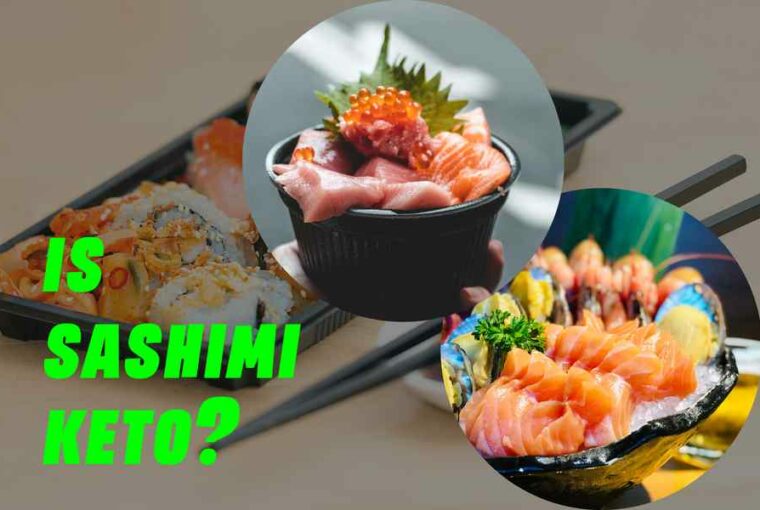If you’ve been on the ketogenic diet for any length of time, you’ll know that there are some foods that are particularly tricky to navigate. While there are plenty of great meat and fish options, many common seafood dishes fall into a grey area when it comes to their overall macronutrient content. Sushi is one such example; although it consists almost entirely of raw fish and vinegared rice, sashimi often has a high carbohydrate and sugar content as a result of being served with soy sauce and wasabi paste. However, it doesn’t have to be this way! With the right preparation methods, sashimi can also be enjoyed by anyone following a keto diet.
Is Sashimi Keto?
Unfortunately, sashimi is not keto friendly. Sashimi is raw fish that has been prepared with a light marinade of vinegar and seaweed. While it may be low in carbs, if you have a severe seafood allergy, you should not eat sashimi. It may contain dangerous bacteria that are not killed by the marinating process. Additionally, fish is high in protein and can lead to feelings of hunger and cravings if you’re not careful.
Why Is not Sashimi Keto?
1. Sashimi Is Unhealthy
Sashimi is high in carbs, which may make you feel hungry. It also contains soy sauce, which can be high in sugar and cause blood sugar spikes. The fish is often served with wasabi paste, which is also high in carbs. This means that sashimi can quickly become a source of unwanted carbs and calories.
2. Sashimi Is Not Very Nutritious
The only real nutritional benefit of sashimi is the inclusion of protein and omega-3 fatty acids from the fish itself. However, these nutrients are very low in quantity, meaning that you’ll be better off by sticking to your usual seafood options on keto, such as salmon or tuna.
3. Sashimi Doesn’t Have Many Nutrients to Offer
The most controversial ingredient in sashimi is the vinegar used to marinate the fish – this can increase your risk of cancer if you have a weak stomach. However, it’s also thought that the low amount of carbohydrates in sashimi means that you’ll be missing out on many of the vitamins and minerals you’d get from other seafood.
4. Sashimi Is Not Easy to Make
There are plenty of fish options on keto, but they often contain more protein than sashimi. Salmon, tuna, and mackerel are all high in protein and omega-3 fatty acids, making them a better option for those following a ketogenic diet.
5. Sashimi Is Expensive
Sashimi is expensive because it requires a great deal of time to prepare – it can take up to two hours to prepare this dish properly! This is due to the vinegar marinade being prepared separately from the fish and rice dish itself. This can lead to food costs quickly rising as you have to buy multiple ingredients as well as extra time spent preparing them!
6. Sashimi Is Not Nutritious
Sashimi is not very nutritious, and the fish itself is often quite low in nutrients. The only real nutritional benefit of sashimi is the inclusion of protein and omega-3 fatty acids from the fish itself. However, these nutrients are very low in quantity, meaning that you’ll be better off by sticking to your usual seafood options on keto, such as salmon or tuna.
7. Sashimi Is Not Easy to Make
There are plenty of fish options on keto, but they often contain more protein than sashimi. Salmon, tuna, and mackerel are all high in protein and omega-3 fatty acids, making them a better option for those following a ketogenic diet.
8. Sashimi Can Be Very Messy
Sashimi can be difficult to eat because it’s usually served raw with wasabi paste on top – this means that you’ll need to be careful when you put it in your mouth as you don’t want to accidentally burn your tongue!
How To Make Sashimi Keto-Friendly?
Use a thin slicing knife
A strong, sharp knife is the most important tool for preparing sashimi. This is because you will need to slice the fish very thinly to make it look as beautiful as possible. You can also use a fish filleting knife to make it easier to remove the bones from the fish. We recommend using a sushi (sashimi) knife because it’s made for slicing fish. Be sure to keep your knife sharp by sharpening it regularly. This will help you to cut the fish better and more safely. You can also use a fish scaler to remove the bones from the fish. However, this tool isn’t as effective as a thin slicing knife.
Choose the right fish
Not all fish are suitable for sashimi. For example, oily fish and fish with a high mercury content are not good for raw consumption. This is because they contain high levels of methylmercury, which is harmful if consumed raw. If you are unsure about which fish you can safely consume raw, you can always ask a fishmonger or a nutritionist. Some fish that are great for sashimi include salmon, tuna, flounder, herring, and mackerel. Keep in mind that salmon and tuna are the most commonly used types of fish for sashimi. Salmon is a great source of protein, omega-3 fatty acids, and vitamins. Tuna is also rich in protein and omega-3 fatty acids.
Season your fish
When you are making sashimi, you should season your fish before slicing it. This will ensure that your fish has an even taste and texture. You can use any type of seasoning, but you should avoid adding too much salt. Seasoning your fish will also help to remove the fishy smell. We recommend using sesame oil, tamari, ginger, or garlic for seasoning. You can also mix sesame oil and soy sauce for a tasty seasoning. This will add a little flavor to your sashimi. Be sure to use a small amount of seasonings since they contain a lot of carbs.
Know your soy sauce
Soy sauce is a popular ingredient for sashimi because it provides a subtle, salty flavor to fish. However, not all brands of soy sauce are keto-friendly. You can find keto-friendly soy sauce, but you need to read the ingredients list carefully. You should avoid soy sauce made with wheat, which is a common ingredient in most brands. Instead, choose a soy sauce made with soybeans, salt, and water. It’s best to avoid low-sodium varieties because they are usually loaded with added carbs.
Pick your vegetables
Many types of vegetables go well with sashimi. However, you need to be careful about the vegetables you choose because some of them are high in carbs. Vegetables that are low in carbs include cucumber, cabbage, and lettuce. You can also try using avocado to make your sashimi look and taste better. It’s a healthy, keto-friendly choice because it contains only 2 grams of carbs per serving. Be sure to peel and slice the avocado before adding it to your sashimi dish.
Serve and enjoy!
You can serve sashimi on a bed of lettuce or cabbage. You can also serve it with a side of vegetables for a complete meal. If you want to make your sashimi look as beautiful as possible, use a fish fork made for sashimi. You can also use chopsticks to eat your sashimi. Sashimi is best served chilled. It’s best to consume it within two hours of making it to prevent the fish from spoiling. When you make sashimi at home, you can enjoy it without the guilt of eating too many carbs.
Conclusion
Sashimi is a delicious traditional raw fish dish that can also be enjoyed by those on a ketogenic diet. The dish is best served with a slice of lemon or lime, alongside a side of tamari, and thinly sliced fish.




